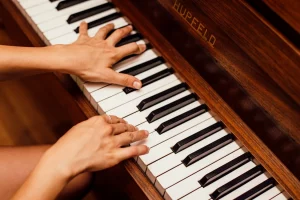Have you ever noticed that special moment in a song when the harmony unexpectedly shifts, bringing a heroic, uplifting or even mysterious feeling to the piece? This effect often comes from a harmonic technique called modal interchange.
Also known as borrowed chords, modal interchange allows composers to pull from different musical modes or scales, adding new colors and emotional twists. In this article, we will explore what modal interchange is and how you can bring its magic into your own playing and compositions.
- Fall in love with the music - Learn your favorite songs, at a level suitable for you.
- Enjoy interactive piano lessons - Explore courses covering music theory, technique chords & more.
- Get real-time feedback - Skoove's feedback tells you what went well and what needs practice.

What is modal interchange?
Modal interchange is the practice of borrowing chords from parallel modes or keys to add new harmonic flavors to a piece, expanding the harmonic palette away from diatonic harmony. Modes are variations of the major or minor scale, each with its own mood due to the different intervals between notes. For example, Dorian, Phrygian and Mixolydian are modes of the major scale, each lending a unique vibe to a piece.
Using borrowed piano chords helps introduce interesting variation without straying from a tonal center. This allows a composer to surprise the listener and create an emotional impact around a structured reliable theoretic concept. For instance, if you’re playing in C major, adding an A♭ major chord (borrowed from the C minor scale) will change the feeling of the chord progression. This ability to shift moods around a tonal center is what makes modal interchange such a powerful tool. How does this use of modal interchange alter your feelings about this chord progression?
C – F – Am – G then interchange to C – F – Ab -G
Modes: A quick theory refresher
Before diving into modal interchange, it’s essential to review some basic theory on piano keys, scales, modes and chords.
Modes: Seven distinct personalities
Each mode has a different ‘personality’ or ‘color’ created by altering the intervals between notes. Here’s a quick breakdown of the major modes:
- Ionian – The “default” major scale, bright and familiar.
- Dorian – Minor feel but with a brighter touch, often associated with jazz and folk music.
- Phrygian – Dark and somewhat exotic, common in Spanish and Middle Eastern music.
- Lydian – Major but with a dreamy, otherworldly sound.
- Mixolydian – Major feel with a bluesy edge, used frequently in rock.
- Aeolian – The natural minor scale, commonly associated with sadness or introspection.
- Locrian – Dissonant and unstable, often used sparingly.
Each mode offers different chords, which can be borrowed to enrich your harmonic palette.
Building chords within modes
Every mode has a set of chords derived from its notes. For example, in C major (Ionian mode), the chords are:
C | (I) |
| Dm | (ii) |
| Em | (iii) |
F | (IV) |
G | (V) |
Am | (vi) |
| Bdim | (vii°) |
By switching to a mode like C Dorian, we’d get a different set of chords, such as a minor iv chord (F minor) and a major ♭VII chord (B♭), providing options for modal interchange.
Why modal interchange works: The theory behind borrowing chords
Modal interchange works by playing on the psychological effects of expectation and surprise. When you listen to music, your brain starts predicting chords and notes based on familiar patterns. Modal interchange subverts these assumptions, introducing a “foreign” chord that catches listeners off guard. This variation surprises the listener, prompting the brain to pay closer attention and feel a sense of resolution when the music returns to a familiar harmony.
In fact, according to a study on music perception, unexpected harmonic shifts increase dopamine release in listeners’ brains, activating the pleasure centers associated with rewarding experiences. Modal interchange is effective because it adds just enough surprise to keep listeners engaged without straying too far from the song’s core harmony.
For pianists modal interchange is a way to further shape emotions and create a unique musical voice. You’re not just playing a series of chords; you’re telling a story, using harmony to create suspense, drama, or nostalgia.
Popular modal interchange chords and their uses
Here are some commonly borrowed modal interchange chords and the emotional textures they add to music:
- ♭VII: Often used to create an epic, triumphant feel. – Borrowed from Mixolydian Dorian or Aeolian.
- iv: Adds a melancholic or nostalgic tone, frequently seen in ballads. – Borrowed from Aeolian, Phrygian and Locrian.
- ♭VI: Darker, dramatic and often used in cinematic music. – Borrowed from Aeolian, Phrygian and Locrian.
- ♭III: Conveys tension or mystery, sometimes lending an exotic feel. Borrowed from Aeolian, Dorian and Phrygian.
Modal interchange chart: Your quick-reference guide
Use modal interchange chart to see the common chords available for borrowing:
| Key (Mode) | Borrowed Chords (Modal Interchange) |
| Major (Ionian) | ♭VII, iv, ♭VI, ♭III |
| Minor (Aeolian) | ♭II, IV, ♮vi, VII, II |
| Dorian | IV, v, VI, ♭VII |
| Mixolydian | I, iv, ♭III, ♭VII |
Refer to this chart often as you practice adding borrowed chords to progressions.
Applying modal interchange to your piano practice
- Creating tension and release: Experiment with borrowed chords to build tension, then return to the original scale for resolution.
- Substituting chords: Try swapping a standard chord for a borrowed one within a progression, such as using a iv chord instead of IV.
- Improvising with borrowed chords: Experiment with modal interchange in improvisation. Incorporating a ♭VII chord (B♭ in C major) can give your improvisation an epic flair.
- Songwriting inspiration: Modal interchange can give your compositions unexpected twists. Iconic songs like “Eleanor Rigby” and “Creep” use modal interchange to create memorable moments.
- Chord extensions: Try exploring the further possibilities and variation available through chord extensions.
Common mistakes and how to avoid them
Let’s explore a few more common mistakes pianists may encounter with modal interchange, along with tips to avoid them:
| Unintentional Chord Choice | Avoid adding borrowed chords without purpose. Each chord should add something meaningful, like tension or mood, rather than being included at random. |
| Overusing Borrowed Chord | Overuse of modal interchange as a whole can dilute its effect and change the tonality of the piece making it unfocused. Use modal interchange strategically to highlight specific moments, creating contrast and emotional shifts without overwhelming the listener. |
| Overusing Certain Borrowed Chords | Relying too much on popular chords like ♭VII or iv can make music predictable. Try lesser-used options like ♭II or ♭III to keep things fresh. |
| Neglecting Ear Training | Modal interchange depends on recognizing tonal subtleties. Skoove’s ear-training exercises help you develop the skills to hear and use modal harmonies effectively. |
Examples of modal interchange in popular songs
Want to see modal interchange in action? Here are a few popular examples:
- “Eleanor Rigby” by The Beatles: This song employs an E minor chord in a C major setting, adding a haunting quality to the melody.
- “Creep” by Radiohead: Uses an F major chord in G major, giving the progression a melancholic and dissonant feel that heightens the song’s emotional impact.
- “Let It Be” by The Beatles: In the key of C major, the song’s use of a ♭VII (B♭ major) provides a subtle but powerful harmonic shift.
These examples highlight how modal interchange can add drama, surprise, and depth to a song’s harmonic structure.
How to train your ear for modal interchange?
Ear training is vital when using modal interchange. The goal is to recognize when a borrowed chord is introduced and understand its effect within the progression. Here are some ways to develop this skill:
| Listen Actively to Songs with Borrowed Chords | Pick songs like “Eleanor Rigby” or “Let it Be” and focus on how the borrowed chords shift the mood, building familiarity with modal interchange. |
| Practice Interval Recognition | Use Skoove’s ear-training to identify intervals, helping you distinguish major, minor, diminished and augmented chords. |
| Play Along with Songs | Identify a song’s key and listen for borrowed chords, matching them on the piano to train your ear for their unique sound. |
Embrace the magic of modal interchange
Modal interchange is a powerful tool to expand your harmonic palette, adding drama, nostalgia, or even suspense to your music. By exploring borrowed chords, you can develop a unique musical voice that resonates deeply with listeners. Skoove’s platform provides practical lessons and exercises, making the complexities of modal interchange accessible and engaging. With hands-on practice, ear training, and real-world examples, Skoove guides you through this rich harmonic territory. So, next time you sit at the piano, go beyond playing and explore. Let modal interchange open new creative paths and add depth to your music.
Author of this blog post:
Susana Pérez Posada

With over seven years of piano education and a deep passion for music therapy, Susana brings a unique blend of expertise to Skoove. A graduate in Music Therapy from SRH Hochschule Heidelberg and an experienced classical pianist from Universidad EAFIT, she infuses her teaching with a holistic approach that transcends traditional piano lessons. Susana’s writings for Skoove combine her rich musical knowledge with engaging storytelling, enriching the learning experience for pianists of all levels. Away from the piano, she loves exploring new places and immersing herself in a good book, believing these diverse experiences enhance her creative teaching style.
Published by Lydia Ogn from the Skoove team















